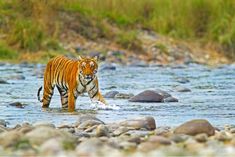India is home to more than 100 National Parks with an immense variety of Flora and Fauna. Some of them are designated as UNESCO Heritage Sites also. Let’s discuss some of the prominent ones.
1. Jim Corbett National Park

Established in 1936, this is India’s first national park. It is named after the legendary naturalist and conservationist Jim Corbett. Located at the Himalayas’ foothills, near the popular hill-station of Nainital, the beautiful Jim Corbett National Park, is famous for being home to a large number of tigers, the highest among any Indian national park. Spread over 1318.54 sq km, of which 520 sq km is the main area, and the remaining is buffer; the park is spread over the picturesque landscapes of Pauri Garhwal, Almora, and Nainital. The jeep safari into the dense forest to see the wild animals in their natural habitat is a must-have experience. And if you are lucky, then you may get a chance to even spot a tiger. While on the jeep safari, enjoy the lush green forest’s views cut across by streams and rivers and a few waterfalls. There are accommodations available inside the park for night-stay as well, which offer you once-in-a-lifetime experience.
2. Great Himalayan National Park

This National Park in the western part of the Himalayan Mountains in the northern Indian state of Himachal Pradesh is characterized by high alpine peaks, alpine meadows and riverine forests. The 90,540 ha property includes the upper mountain glacial and snow meltwater sources of several rivers, and the catchments of water supplies that are vital to millions of downstream users. It is part of the Himalaya biodiversity hotspot and includes twenty-five forest types along with a rich assemblage of fauna species, several of which are threatened. This gives the site outstanding significance for biodiversity conservation.
It is declared as UNESCO World Heritage Site in June 2014. There are several popular trekking routes in the park, ranging from those that can be done in a day or two, to mesmerizing Tirthan Valley, Jhibhi also known as Mini Thailand . Ecotourism and homestay tourism has also being gaining popularity in places near to the park.
3.Sasan Gir National Park
Gir National Park is the only place in the world outside Africa where a lion can be seen in its natural habitat. The Lions of Gir are a majestic animal, averaging 2.75 metres in length, and with a bigger tail tassle, bushier elbow tufs and prominent belly folds than his African cousin which has larger mane. Gir is a home to 40 species of mammals and 425 species of birds. Established by Nawab of Junagarh‘s private hunting area in 1965, with a total area of 1,410.30 km2 (544.52 sq mi), of which 258.71 km2 (99.89 sq mi) is fully protected as a national park and 1,151.59 km2 (444.63 sq mi) as wildlife sanctuary. It is part of the Khathiar-Gir dry deciduous forests ecoregion. The count of 2,375 distinct fauna species of Gir includes about 38 species of mammals, around 300 species of birds, 37 species of reptiles and more than 2,000 species of insects. The carnivores group mainly comprises the Asiatic lion, Indian leopard, jungle cat, striped hyena, golden jackal, Bengal fox, Indian gray mongoose, ruddy mongoose, and honey badger. Asiatic wildcat and rusty-spotted cat occur, but are rarely seen.

The main herbivores of Gir are chital, nilgai, sambar, four-horned antelope, chinkara and wild boar. Blackbucks from the surrounding area are sometimes seen in the sanctuary. Among the smaller mammals, porcupine and hare are common, but the pangolin is rare. The Sasan Gir National Park is an esteemed wildlife destination in India which has attained an immense popularity among vivid travellers, wildlife lovers, photographers, nature enthusiasts, researchers and hunters. Being the only destination to spot the Asiatic Lions in India, it keeps on attracting large number of travellers from several parts of the world for its Wildlife Safaris.
4. Silent Valley National Park
Silent Valley National Park is a national park in Kerala, India. It is located in the Nilgiri hills and has a core area of 89.52 km2 (34.56 sq mi). It is surrounded by a buffer zone of 148 km2 (57 sq mi). This national park has some rare species of flora and fauna. Silent Valley National Park was explored in 1847 by the botanist Robert Wight.[2] It is located in the border of Mannarkkad Taluk of Palakkad district, Nilambur Taluk of Malappuram district, Kerala, and Nilgiris district of Tamil Nadu.
It is located in the rich biodiversity of Nilgiri Biosphere Reserve. The Karimpuzha Wildlife Sanctuary, New Amarambalam Reserved Forest, Nedumkayam Rainforest in Nilambur Taluk of Malappuram district, Attappadi Reserved Forest in Mannarkkad Taluk of Palakkad district, and Mukurthi National Park of Nilgiris district are located around Silent Valley National Park. Mukurthi peak, the fifth-highest peak in South India, and Anginda peak are also located in its vicinity. The Bhavani River, a tributary of the Kaveri River, and Kunthipuzha River, a tributary of Bharathappuzha river, originate in the vicinity of Silent Valley. The Kadalundi River also originates in Silent Valley National Park.

Silent Valley National Park
The national park is one of the last undisturbed tracts of South Western Ghats mountain rain forests and tropical moist evergreen forest in India. Contiguous with the proposed Karimpuzha National Park (225 km2 (87 sq mi)) to the north and Mukurthi National Park (78.46 km2) to the north-east, it is the core of the Nilgiri Biosphere Reserve (1,455.4 km2), and is part of the Nilgiri Sub-Cluster (6,000+ km2), Western Ghats World Heritage Site, recognised by UNESCO in 2007.[3]
Plans for a hydroelectric project that threatened the park’s biodiversity stimulated an environmentalist social movement in the 1970s, known as the Save Silent Valley movement, which resulted in cancelling the project and creating the park in 1980. The visitors’ centre for the park is at Sairandhri.
5. Kaziranga National park
Kaziranga National Park is a national park in the Golaghat, Sonitpur, Biswanath and Nagaon districts of the state of Assam, India. KNP has 5 ranges. The park, which hosts two-thirds of the world’s Indian rhinoceroses, is a UNESCO World Heritage Site. According to a March 2018 census conducted jointly by the Forest Department of the Government of Assam and some recognized wildlife NGOs, the rhino population in Kaziranga National Park is 2,613. It comprises 1,641 adult rhinos and 385 calves.
In 2015, the rhino population stood at 2,401. Kaziranga National Park was declared a Tiger Reserve in 2006. The park is home to large breeding populations of elephants, wild water buffalo, and swamp deer. Kaziranga is recognized as an Important Bird Area by BirdLife International for conservation of avifaunal species which refers as the birds or types of birds found in a specific region, period, or environment. When compared with other protected areas in India, Kaziranga has achieved notable success in wildlife conservation. Located on the edge of the Eastern Himalaya biodiversity hotspot, the park combines high species diversity and visibility.

Indian Rhinoceros
Kaziranga is a vast expanse of tall elephant grass, marshland, and dense tropical moist broadleaf forests, criss-crossed by four major rivers, including the Brahmaputra, and the park includes numerous small bodies of water. Kaziranga has been the theme of several books, songs, and documentaries. The park celebrated its centennial in 2005 after its establishment in 1905 as a reserve forest.
The history of Kaziranga as a protected area can be traced back to 1904, when Mary Curzon, Baroness Curzon of Kedleston, the wife of the Viceroy of India, Lord Curzon of Kedleston, visited the area. After failing to see a single-horned rhinoceros, for which the area was renowned, she persuaded her husband to take urgent measures to protect the dwindling species which he did by initiating planning for their protection. On 1 June 1905, the Kaziranga Proposed Reserve Forest was created with an area of 232 km2 (90 sq mi).
